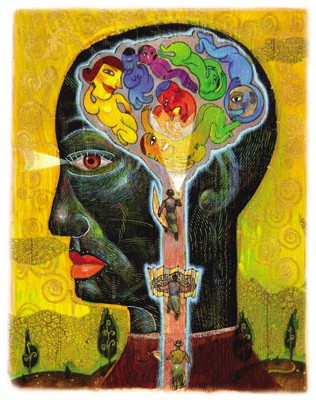Apocalyptic dreams, those vivid and often unsettling visions of the world’s end, have captured the human imagination for centuries. These nocturnal fantasies hold a mirror to our deepest fears, hopes, and anxieties. In this article, we delve into the fascinating realm of apocalyptic dreams, exploring the science behind them through the lens of neuroscience.
The Neurobiology of Dreaming
Our journey begins with the enigmatic landscape of dreaming itself. Dreams occur during the rapid eye movement (REM) stage of sleep, a time when our brain activity is surprisingly similar to that of being awake. The brainstem and thalamus play a pivotal role in orchestrating sleep cycles, while the cortex becomes the canvas upon which dreams are painted. The interaction between the cortex and the limbic system, responsible for emotions and memories, gives rise to the intricate stories we experience during sleep.
Apocalyptic Dreams: Typology and Themes
Apocalyptic dreams come in various forms, from global catastrophes to personal survival scenarios. These dreams often tap into universal themes of disaster, survival, and societal collapse. Cultural backgrounds and psychological experiences shape the content of these dreams, illustrating how they serve as a reflection of our collective and individual anxieties.
The Unconscious Mind: Symbolism and Meaning
Deep within the unconscious mind lies a rich tapestry of symbolism. In apocalyptic dreams, familiar objects and events take on new, sometimes surreal, meanings. The Freudian and Jungian perspectives on dream analysis offer insight into how our hidden desires, fears, and archetypes manifest in these dreams, allowing us to better understand the complex narrative threads woven within them.
Neuroscience of Fear and Anxiety

Fear and anxiety, primal emotions deeply embedded within our psyche, find their way into our dreams. The amygdala, a small almond-shaped structure in the brain, is a central player in processing fear. During apocalyptic dreams, the amygdala’s activation triggers emotional responses, while stress can increase the occurrence of these dreams. As neuroscientists uncover more about these connections, a clearer picture emerges of how our emotions and dreamscapes intertwine.
Dreams as Emotional Processing
Dreams, it seems, are not merely random sequences of events but rather a mechanism for processing emotions. The REM sleep phase, rich in dream activity, aids in emotional regulation. Apocalyptic dreams may serve as a cathartic outlet, allowing us to confront and release pent-up negative emotions. This notion highlights the intricate dance between our subconscious mind and our emotional well-being.
Neurological Factors Influencing Dream Content
Our dreamscapes are influenced by the complex interplay of neurotransmitters like serotonin and dopamine. These chemicals shape the content and tone of our dreams, dictating whether we experience euphoric flights of fancy or dark, apocalyptic visions. The prefrontal cortex, responsible for decision-making and cognitive control, also plays a role in dream content, while circadian rhythms and sleep disorders can add unexpected twists to our dream narratives.
Cognitive Significance of Apocalyptic Dreams
Evolutionary theories propose that dreaming served an adaptive purpose for our ancestors, aiding in problem-solving and survival skills. Apocalyptic dreams, in their portrayal of dire circumstances, might continue this cognitive function. These dreams could stimulate our minds to develop contingency plans, exploring potential strategies for navigating crises, both real and imagined.
Lucid Dreaming and Apocalyptic Scenarios
Lucid dreaming, the art of becoming aware that one is dreaming, opens a doorway to unique possibilities within the realm of apocalyptic dreams. Dreamers can gain some control over their dream narratives, potentially altering the outcomes of these nightmarish scenarios. With this control comes the opportunity to face fears head-on, and even transform these dreams into therapeutic tools for managing anxiety.
Neuroscience Meets Dream Interpretation
The marriage of neuroscience and Dreaming with PsychoSick dream research has yielded groundbreaking insights. Emerging technologies like neuroimaging offer glimpses into the brain’s activity during dreams, shedding light on the neural pathways involved. However, dreams remain inherently subjective experiences, posing challenges in objectively studying their content. This intersection of science and subjectivity enriches our understanding of dreams, encouraging us to explore their depths with a multidimensional perspective.
Conclusion
As we journey through the scientific landscape of apocalyptic dreams, it becomes clear that these nocturnal visions are not mere flights of fancy. Rather, they offer a window into the human psyche, revealing our deepest fears, hopes, and emotions. Neuroscientists continue to peel back the layers of this complex phenomenon, casting light upon the intricate dance between our brains and our dreams. As our understanding deepens, the mysteries of apocalyptic dreams remind us that the mind’s abyss is as captivating as it is enigmatic.
Frequently Asked Questions (FAQs)
- What triggers apocalyptic dreams?
Apocalyptic dreams can be triggered by a combination of stress, anxieties, and the brain’s natural processes during REM sleep. - Are all apocalyptic dreams negative, or do they have positive interpretations too?
While apocalyptic dreams often feature negative scenarios, they can also symbolize personal transformation and growth. - Can recurring apocalyptic dreams indicate an underlying psychological issue?
Recurring apocalyptic dreams might signal unresolved emotional conflicts, but they don’t necessarily indicate a severe psychological issue on their own. - How can understanding the neuroscience of dreams improve mental health treatments?
By understanding how dreams relate to emotions and the brain, therapists can tailor treatments to help individuals process and manage their emotions more effectively. - Is there a connection between apocalyptic dreams and real-world anxieties?
Yes, apocalyptic dreams can reflect and amplify real-world anxieties, serving as a way for the mind to process and cope with these concerns.
- Can lucid dreaming be used as a tool to overcome the fear associated with apocalyptic dreams?
Yes, lucid dreaming allows individuals to confront and even reshape the content of their dreams, providing a potential avenue for reducing fear and anxiety related to apocalyptic scenarios. - Are there any ethical concerns related to using neuroimaging in dream research?
Ethical concerns may arise regarding privacy and consent when using neuroimaging techniques to study dreams. Researchers must navigate these issues carefully. - What role do hormones play in shaping the themes of dreams, including apocalyptic ones?
Hormones like cortisol and adrenaline, influenced by stress and anxiety, can impact dream content, potentially leading to more intense and apocalyptic scenarios. - Can learning more about the brain’s activity during apocalyptic dreams help predict future societal trends?
While studying dream content can provide insights into collective fears and hopes, directly predicting future societal trends based on dream content rema read here ins speculative.

Welcome to my website! My name is Patrick Petherick, and I am a professional Emotional Dream Coach. I am passionate about helping individuals understand the profound symbolism and meaning behind their dreams, and guiding them towards emotional healing and personal growth. Check it




